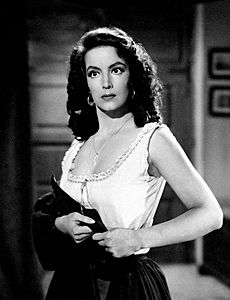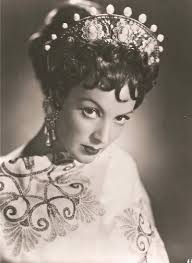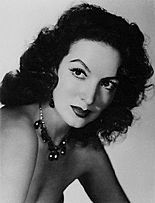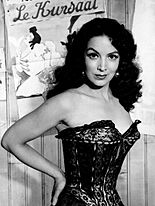María Félix facts for kids
Quick facts for kids
María Félix
|
|
|---|---|

María Félix in The Kneeling Goddess (1947)
|
|
| Born |
María de los Ángeles Félix Güereña
8 April 1914 |
| Died | 8 April 2002 (aged 88) Mexico City, Mexico
|
| Resting place | Panteón Francés de San Joaquín |
| Other names | La Doña María Bonita |
| Occupation |
|
| Years active | 1942–1978 |
| Spouse(s) |
Enrique Álvarez
(m. 1931; div. 1938)Alex Berger
(m. 1956; died 1974) |
| Partner(s) | Antoine Tzapoff (1980s) |
| Children | Enrique Álvarez Félix |
| Signature | |
 |
|
María Félix (born María de los Ángeles Félix Güereña; 8 April 1914 – 8 April 2002) was a famous Mexican actress and singer. She was one of the biggest stars in Latin American movies during the 1940s and 1950s. She starred alongside other famous actors like Pedro Armendáriz and Dolores del Río.
María Félix was known for her beauty and strong personality. People called her La Doña, a nickname from her role in the movie Doña Bárbara (1943). She was also called María Bonita because her second husband, Agustín Lara, wrote a song for her with that name. She made 47 films in Mexico, Spain, France, Italy, and Argentina.
Contents
Early Life and Family
María de los Ángeles Félix Güereña was born in Álamos, Sonora, Mexico, on April 8, 1914. Her father, Bernardo Félix Flores, was a military officer. Her mother, Josefina Güereña Rosas, grew up in California. María had fifteen brothers and sisters.
She spent her early childhood in Álamos. She was very close to her brother Pablo. Later, her family moved to Guadalajara.
When María was 17, her beauty was noticed. She won the title of Beauty Queen at the University of Guadalajara. There, she met Enrique Álvarez Alatorre, a salesman. They married in 1931.
In 1935, María gave birth to her only child, Enrique, who was nicknamed Quique. Her marriage to Enrique Álvarez ended in divorce in 1937. After her divorce, María moved to Mexico City with her son.
Career in Film
Starting Out in Movies
One day in Mexico City, a film director named Fernando Palacios saw María Félix. He asked her if she wanted to be in movies. Palacios helped her learn about acting and introduced her to people in the film industry.
She even went to Hollywood and met director Cecil B. DeMille. He offered her movie roles there, but María wanted to start her career in Mexico.
Her first movie was El Peñón de las Ánimas, directed by Miguel Zacarías. In this film, she starred with the popular actor Jorge Negrete. They did not get along well at first. This movie helped create María Félix's image as a strong and confident woman.
María Félix became known as La Doña after her role in the movie Doña Bárbara (1943). This film was based on a novel by Rómulo Gallegos. The author himself was impressed by María and said, "Here is my Doña Bárbara!"
She worked with director Fernando de Fuentes on other films like La Mujer sin Alma (1944) and La Devoradora (1946). These movies often showed her playing strong, independent women.
María Félix also worked with director Emilio Fernández. They made three successful films: Enamorada (1946), Río Escondido (1947), and Maclovia (1948). She won her first Ariel Awards for Enamorada and Río Escondido.
European Films
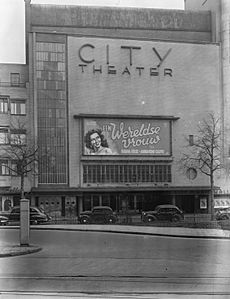
In 1948, María Félix started making movies in Europe. Her first European film was Mare Nostrum (1948) in Spain. She also made films in France and Italy.
One important film was Messalina (1951), which was a very expensive Italian movie for its time. She also filmed La pasión desnuda (1952) in Argentina.
After a short return to Mexico, María Félix went back to Europe. She made films like La Belle Otero (1954) and Les Héros sont Fatigués (1955) in France. A very famous film from this time was French Cancan (1954), directed by Jean Renoir.
Later Career
María Félix returned to Mexico in 1955. During this time, she often starred in movies about the Mexican Revolution. She worked again with Pedro Armendáriz in films like La Escondida (1955).
In 1956, she starred in Tizoc with Pedro Infante. She also made Beyond All Limits (1957) with Jack Palance. In 1959, she appeared in The Soldiers of Pancho Villa with Dolores del Río.
In the 1960s, María Félix made fewer films. Her last movie was La Generala in 1970. Her final acting job was in the Mexican TV show La Constitución (1971). She tried to return to movies later but it did not happen.
María Félix was offered roles in Hollywood many times. However, she often turned them down because she felt the roles were not right for her. For example, she refused roles in Duel in the Sun and The Barefoot Contessa.
Personal Life
María Félix was married four times. Her first marriage was to Enrique Álvarez Alatorre (1931–1938), and they had her only son, Enrique Álvarez Félix. María sent her son to schools abroad when he was young. Later, Enrique became an actor himself. María was very proud of him. His unexpected death in 1996 deeply saddened her.
Her second marriage was to the famous composer Agustín Lara (1945–1947). María had been a fan of his music since she was a teenager. They had a very public relationship. Lara wrote many songs for her, including the famous "María Bonita". Their marriage ended in 1947.
After her second divorce, María Félix had relationships with other well-known men. In 1953, she married actor and singer Jorge Negrete. They had worked together before and had a difficult start, but this time they fell in love. Their wedding was a big event. Sadly, Negrete was already ill and passed away just eleven months later in 1953. María's choice of clothing at his funeral caused some discussion, and she went back to Europe for a time.
Her fourth marriage was to French banker Alexander Berger (1956–1974). They were married for 18 years. During this time, María built her famous home, La Casa de las Tortugas (The House of Turtles), in Cuernavaca. Berger died in 1974, which caused María great sadness. To cope, she found a new hobby: horses. Her horses won many awards.
Her last romantic partner was the painter Antoine Tzapoff. María said about him, "I don't know if he's the man who has most loved me, but he's who has loved me better."
People often thought there was a rivalry between María Félix and Dolores del Río, another big Mexican film star. But María said they were friends and respected each other. She explained that they were very different people.
Style and Influence
María Félix was a model for many famous painters. Artists like Diego Rivera, Leonor Fini, and Leonora Carrington painted her. In the 1980s, her last partner, Antoine Tzapoff, painted many portraits of her.
Many writers also found inspiration in María Félix. Some dedicated novels to her, including Luis Spota and Carlos Fuentes. Songs were also written for her, such as María de Todas las Marías by Juan Gabriel.
In fashion, María Félix was known for her amazing style. She wore clothes by famous designers like Christian Dior, Givenchy, and Yves Saint Laurent. She loved collecting beautiful antiques and had a large jewelry collection.
She famously asked Cartier to create unique pieces for her. In 1968, they made a serpent necklace covered in diamonds. In 1975, she asked for a necklace shaped like two crocodiles, one covered in yellow diamonds and the other in emeralds. These pieces are now displayed in museums around the world as part of The Art of Cartier Collection. Cartier even created a collection of watches and jewelry called La Doña de Cartier to honor her.
Death and Legacy
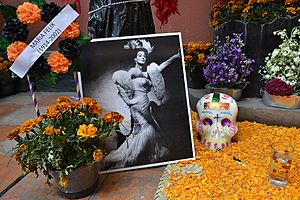
María Félix passed away in her sleep on April 8, 2002, which was also her 88th birthday. She was buried in her family's tomb in Mexico City.
Her legacy continues to be celebrated. In 2018, Google honored her with a Google Doodle on her birthday. A cartoon version of María Félix even appears briefly in the 2017 Pixar movie Coco.
In 2022, a TV show about her life, María Félix: La Doña, was released.
Discography
- La voz de María y la inspiración de Agustín (RCA Víctor, 1964)
Side one:
- "Por qué negar"
- "Gotas de amor"
- "Escarcha"
- "Limosna"
- "Noche de ronda"
- "Te quiero"
Side two:
- "Volverás"
- "Una cualquiera"
- "Arráncame la vida"
- "Cada noche un amor"
- "Rival"
- "Solamente una vez"
- Enamorada (Fonovisa, 1998)
- "Ella"
- "La cigarra"
- "El corrido del norte"
- "Pobre corazón"
- "La noche de mi mal"
- "Cada noche un amor"
- "Mano a mano"
- "De mi barrio"
- "Escándalo"
- "Silencio"
- "Et maintenant"
- "Je l'aime à mourir"
- "Prends garde"
See also
 In Spanish: María Félix para niños
In Spanish: María Félix para niños


